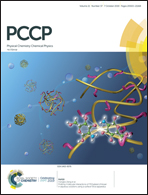Quasiperiodic behavior in the electrodeposition of Cu/Sn multilayers: extraction of activation energies and wavelet analysis†
Abstract
Living systems are one of the many examples in which self-organizing systems yield more intricate structures than those that can be achieved using a “step-by-step” approach. This phenomenon can be observed in electrochemical organic synthesis, oscillating metal deposition and in chemical clocks. There is a plenitude of temporal instabilities during self-organization, from ordinary period-one oscillations, going through quasiperiodicity, to the onset of chaos. Here, we describe the emergence of quasiperiodic behavior during the oscillatory electro-deposition of Cu/Sn. The time-series were characterized using a continuous wavelet transform in order to extract the oscillation frequency of the process with changes in temperature, and to calculate the apparent activation energies. Two different energy ranges are presented, and these are attributed to an activation barrier (∼50 kJ mol−1) which is closely related to a fast time-scale of the feedback loops responsible for the current oscillations and a diffusional process (∼20 kJ mol−1), connected to the slow modulations of the oscillation amplitude, giving rise to quasiperiodic dynamics. This kinetic information might provide information on the self-organized synthesis of Cu/Sn metallic multilayers which are kept far from the thermodynamic equilibrium. As self-organization in chemical systems is rapidly developing into a powerful strategy for designing new functional materials, the availability of kinetic parameters is of major interest in rational design.



 Please wait while we load your content...
Please wait while we load your content...